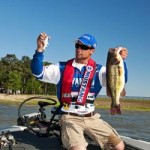And How: Randy Howell’s Charmed Last Day Leads To Bassmaster Classic Victory
from The Fishing Wire
BIRMINGHAM, Ala. – Every angler dreams of catching bass after giant bass like Randy Howell did on Sunday.
Randy Howell of Springville, Ala., wins the GEICO Bassmaster Classic presented by Diet Mountain Dew and GoPro. Bringing in a three-day total of 67 pounds, 8 ounces earned Howell the championship title and $300,000.
Photo by Gary Tramontina/Bassmaster
Howell began hauling in Lake Guntersville lunkers minutes into the final round of the GEICO Bassmaster Classic presented by Diet Mountain Dew and GoPro. He lost track of how many culls he was able to make, but at one point he was trading 4- and 5-pounders for even larger bass.
When Howell brought his bag to the scales, his five bass weighed 29 pounds, 2 ounces, with the largest going 7-3. The banner day beefed up his total to 67 pounds, 8 ounces.
“I don’t even know if I’m going to win, but it doesn’t matter,” Howell said before all the 25 finalists came to the scales. “It was the best day I’ve ever had in 21 years of professional bass fishing, a day of a lifetime.”
But his day did get better: He became the world champion, the 2014 Bassmaster Classic champ.
“I’ve had this dream so many times, and it’s happening now. I can’t believe I won the Bassmaster Classic. I don’t win tournaments very often,” said Howell as he was announced the winner.
Howell is a two-time Bassmaster event winner, including a 2013 Bass Pro Shops Bassmaster Northern Open presented by Allstate event that earned him his 2014 Classic qualification.
Sunday’s victory – Howell’s first after 11 other tries as a Classic competitor – was worth $300,000 and the most coveted trophy in the sport. From Springville, Ala., Howell became only the second angler to win the Classic in his home state.
Howell edged out B.A.S.S. Nation qualifier Paul Mueller of Naugatuck, Conn., by 1 pound. Mueller, who on Day 2 set a new one-day Classic weight record at 32-3, totaled 66-8 for second place.
Third place was claimed by second-day leader Edwin Evers of Talala, Okla., with 65-11. Fourth was Ott DeFoe of Knoxville, Tenn., with 63-6, including the day’s largest bass, an 8-4. First-day leader Randall Tharp of Port St. Joe, Fla., finished in fifth place at 62-12.
Howell repeatedly used the words “perfect” and “effortless” to describe his day on Lake Guntersville.
“I caught my first one on my second or third cast,” he said. “I caught one almost every cast or two and had a limit in the first 10 or 15 minutes. It was quick. It would have been quicker if I hadn’t had to stop and retie every time because of the rocks.”
The rocks were the riprap up against a causeway bridge on Spring Creek. That early flurry included releasing eight 4-pounders.
Howell spent most of his time on the riprap. He moved only once, going farther back into the creek to a grassy area. The move yielded a 6-pounder and allowed him to cull a 4-pounder. He then motored back to the riprap. His largest was a 7-3. It was his fourth bass of the day and the one that told him he’d made the right decision to go to Spring Creek.
His Classic lure arsenal included a Livingston Lures model being developed within the Pro Series. Not yet available to the public, it’s a medium diver in a crawfish color. He also used a Rapala DT6 crankbait in the “demon” crawfish color and a Yamamoto bladed jig.
“I went out this morning believing I could win,” the champ said. “That’s the weirdest thing. Typically, I would never be in 11th place and 9 pounds back and think I had a chance to win. But for some reason I had the feeling I could win on Spring Creek – that something big would happen there.”
Fred Roumbanis’ 9-3 largemouth from Day 1 won the event’s Carhartt Big Bass Award of $1,000 plus $1,500 for wearing Carhartt clothing.
Howell earned a $7,500 Toyota Bonus Bucks award.
Tharp received the Day 1 GEICO Everyday Leader Award of $1,000 plus $1,500 for having a GEICO decal on his boat’s windshield. Evers won the same bonus on Day 2.
Fans can catch 12 hours of Classic coverage on ESPN2 on The Bassmasters. The first hour will air Saturday, March 1, at 10 a.m. ET. The show centered on Sunday’s finale will air in prime time – 8 to 10 p.m. ET – on Sunday, March 2.
2014 Bassmaster Classic Title Sponsor: GEICO
2014 Bassmaster Classic Presenting Sponsors: Diet Mountain Dew, GoPro
2014 Bassmaster Classic Official Sponsors: Toyota, Bass Pro Shops, Berkley, Evan Williams Bourbon, Humminbird, Mercury, Minn Kota, Nitro Boats, Skeeter Boats, Triton Boats, Yamaha
2014 Bassmaster Classic Outdoors Expo Presenting Sponsor: Dick’s Sporting Goods
2014 Bassmaster Classic Official Apparel Sponsor: Carhartt
About B.A.S.S.
For more than 45 years, B.A.S.S. has served as the authority on bass fishing. The organization advances the sport through advocacy, outreach and an expansive tournament structure while connecting directly with the passionate community of bass anglers through its Bassmaster media vehicles.
The Bassmaster brand and its multimedia platforms are guided by a mission to serve all fishing fans. Through its industry-leading publications – Bassmaster Magazine and B.A.S.S. Times – comprehensive website Bassmaster.com and ESPN2 and Outdoor Channel television programming, Bassmaster provides rich, leading-edge content true to the lifestyle.
The Bassmaster Tournament Trail includes the Bassmaster Elite Series, Bass Pro Shops Bassmaster Open Series, B.A.S.S. Nation events, Carhartt Bassmaster College Series, Bassmaster High School Series, Bassmaster Team Championship and the ultimate celebration of competitive fishing, the Bassmaster Classic.
B.A.S.S. offers an array of services to its more than 500,000 members and remains focused on issues related to conservation and water access. The organization is headquartered in Birmingham, Ala.



